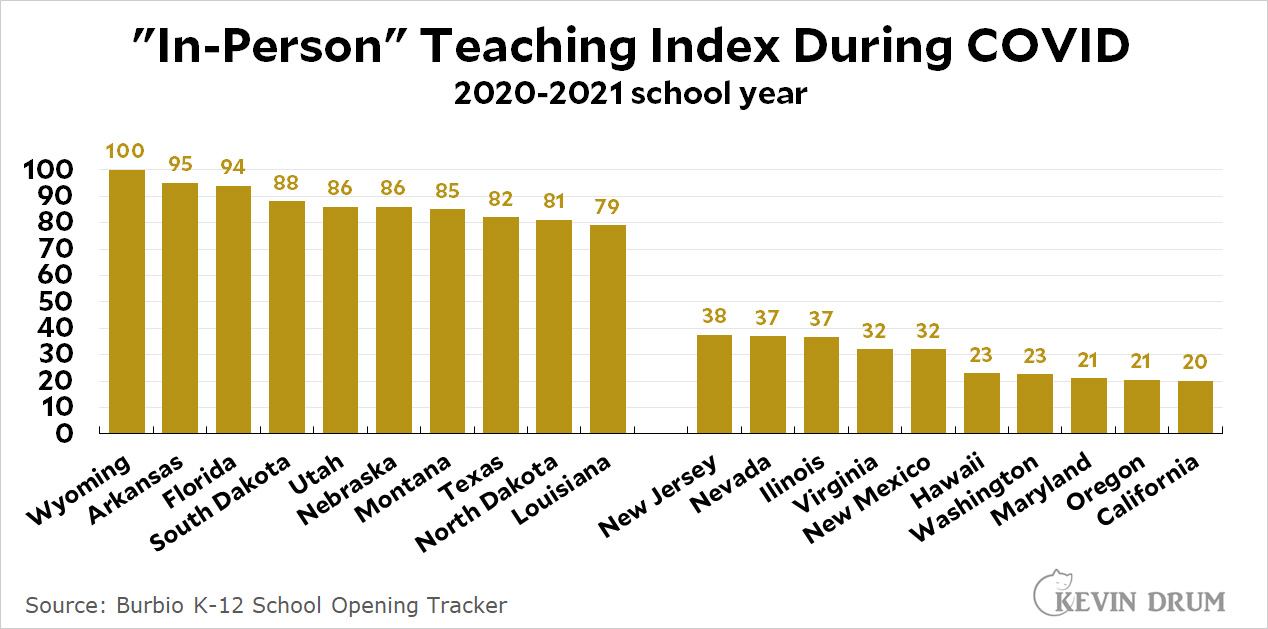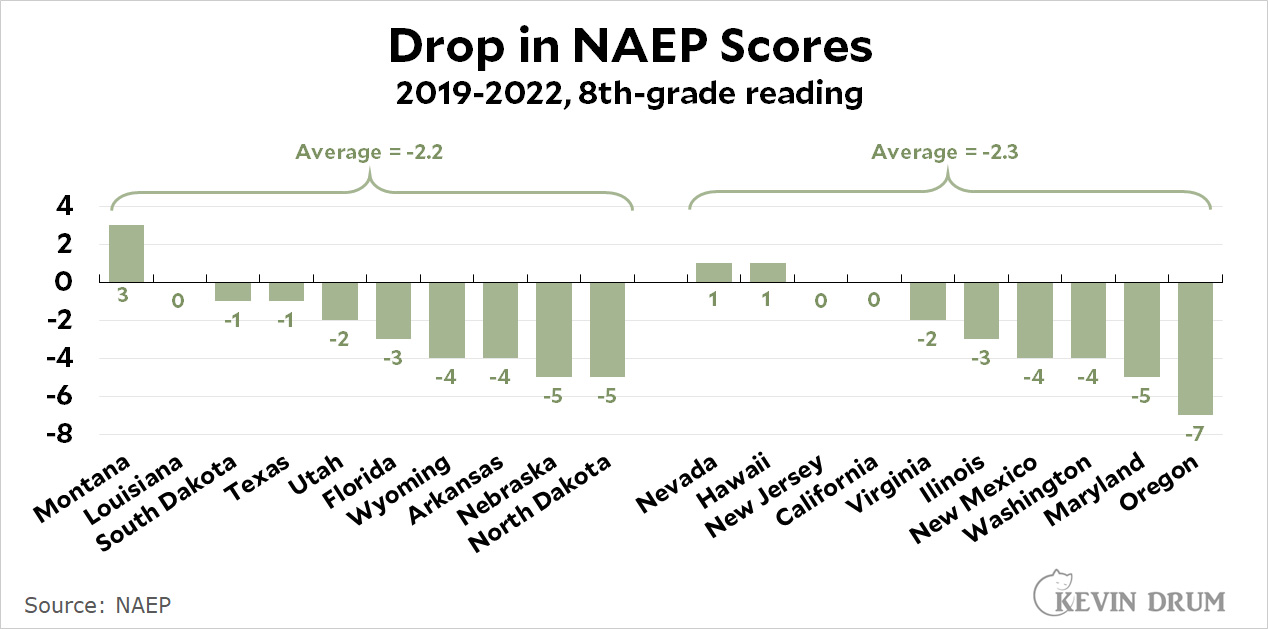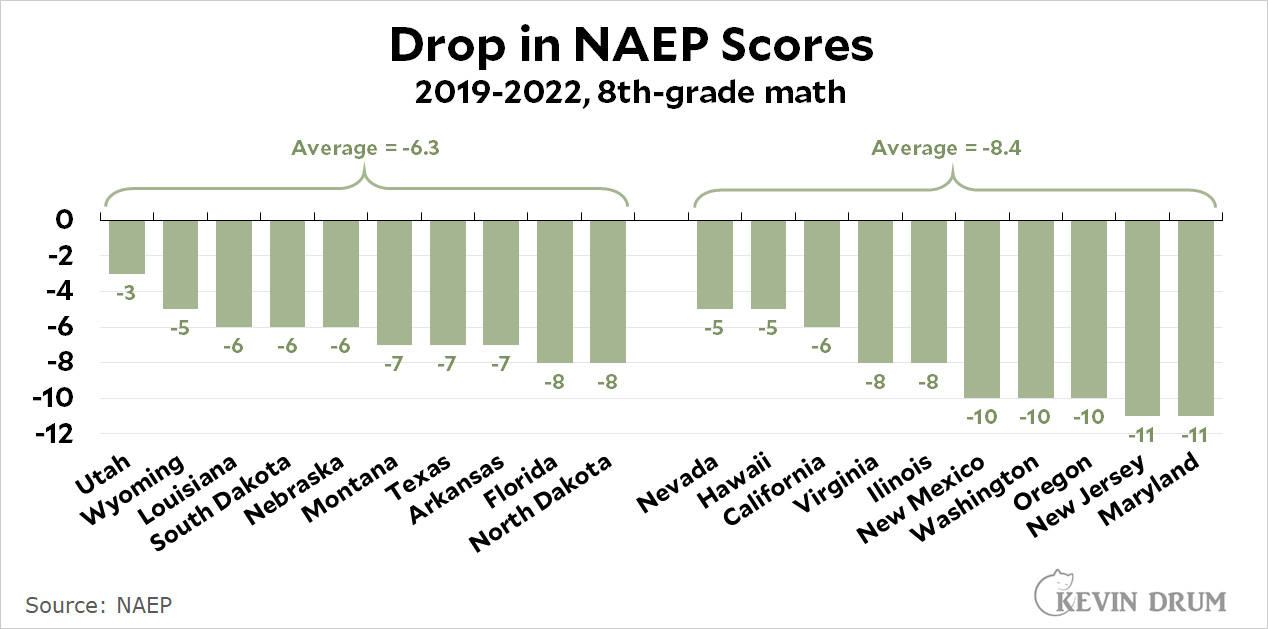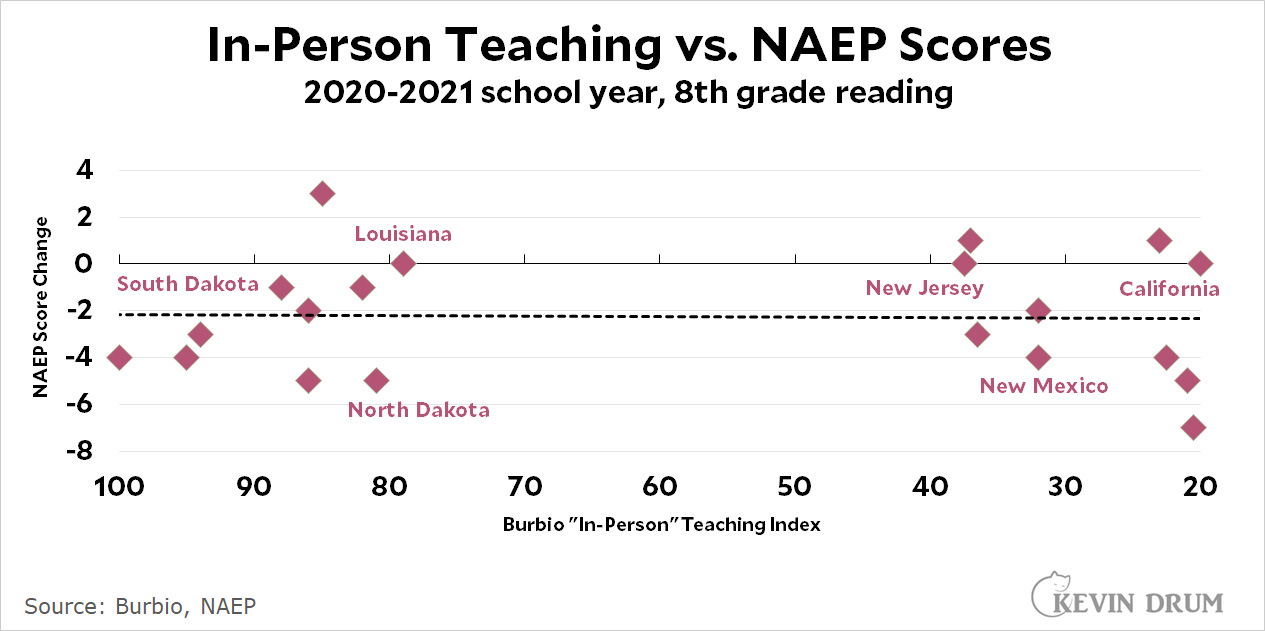We all know that NAEP test scores dropped substantially between 2019 and 2022, largely due to virtual teaching replacing in-person teaching. At least, that's what we think happened.
I got curious about this the other day: Did states that kept schools open during the 2020-2021 school year do better than states that closed schools? First, here is an "in-person" teaching index from Burbio. I've included the top ten and bottom ten states:
 Now, for the same states, here's the change in NAEP reading scores for 8th graders. This compares scores from before and after the pandemic:
Now, for the same states, here's the change in NAEP reading scores for 8th graders. This compares scores from before and after the pandemic:

 In reading, the average score decline in the top states was -2.2, The average in the worst states was -2.3. In other words, there was no difference.
In reading, the average score decline in the top states was -2.2, The average in the worst states was -2.3. In other words, there was no difference.
In math, the average score decline in the top states was -6.3. The average in the worst states was -8.4. There was more difference in math, but it was small and every single state declined. There's nothing to write home about here.
Here's a different way of looking at it:
 There's just nothing there. If I were less lazy I'd do a scatterplot for all 50 states, but I really doubt we'd see anything much different. Despite all the conventional wisdom, it looks like closing schools really didn't make much difference. Something else about COVID was responsible for the score declines.
There's just nothing there. If I were less lazy I'd do a scatterplot for all 50 states, but I really doubt we'd see anything much different. Despite all the conventional wisdom, it looks like closing schools really didn't make much difference. Something else about COVID was responsible for the score declines.
POSTSCRIPT: The best test scores in reading were in military schools, which went up 2 points. The worst were in Maine, which dropped -8 points. The national average was -3 points.
The best test scores in math were once again in military schools, which stayed even at 0 points. The worst were in Delaware, which dropped -13 points. The national average was -8 points.

DON'T CONFUSE ME WITH DATA!!!
MY MIND IS MADE. UP!!!
It's good that you've been convinced to change your mind.
I would argue that in-person teaching had just as many disruptive stressors, including the fear of getting deathly ill or seeing dozens of classmates suddenly removed from school, placed in isolation. Even just one classmate's death would have had a severe psychological effect. And every minute in class you were reminded that this wasn't normal times -- everyone wearing masks, social distancing, limited contact, frequent handwashing, etc.
It's obviously the greedy teacher's unions that are responsible. They always are. /s
As a an over-paid, unaccountable, pension-chasing, unionized civil servant, (albeit retired in 2022) I personally resent those remarks.
Oops. I meant "public school teacher".
A while ago, you did a post saying that the IQ scores of disadvantaged children are always and everywhere lower than the IQ scores of privileged children, when a group's status improves its kids score better on IQ tests, and when a group's status goes down its kids score worse.
The best guess for why this is, is that being socially disadvantaged is stressful, and stress lowers IQ.
That would be consistent with this - the pandemic was stressful for everyone, with social isolation and fear of infection. The kids were stressed, they did worse in school.
No, that's YOUR GUESS as to why the linkage exists.
A different theory, which strikes me as more plausible, is that the primary way to "rise in status" is to adopt bourgeois values, and those lead to the whole constellation of issues that improve IQ - better care of children, ability to abstract, more reading, etc.
Jews across the world, and Chinese in the US, both had higher IQs before they were considered "high status" by whoever it is who bestows high status. But they had bourgeois values. And of course Thomas Sowell's trilogy is essentially 1000+ pages ramming this point home again and again.
Scores are important, but more important was protecting kids from a virus of which we did not know enough , donja think?
We're still discovering new things about this virus such as its ability to remain in some tissues after the acute disease is over. Prudence is justified.
However, here is a common argument: school kids were the least likely to develop a deadly or severe case of Covid-19 -- an observation which has held up in subsequent experience. MAGATs love to point this out. Of course, 30-odd kids in close quarters are likely to spread the disease to each other, no matter how mild a form it takes, which in turn has them take it home to older members of their families (parents and especially grandparents) as well as pass it to teachers -- all had a good chance to be of an age where the effect of the disease would be more severe.
It was a strong measure but a utterly sensible one from a public health perspective, lowering community Rn significantly, but we all know that MAGATs think public health is all government lies.
Yes, people ignored the fact that schools are workplaces for adults.
My anecdotal take from being a parent, school volunteer, and school staff member over the last decade:
Just because you weren't officially closed, it didnt mean there weren't a lot of disruptions due to quarantines. Every time a case showed up, all the kids around the infected kid had to quarantine at home. Because it was pretty impossible to simultaneously teach both online and in person, teachers routinely had large percentages of their classes missing out on instruction. That caused teachers to slow down their lessons and frequently reteach content, resulting in less content being taught overall.
Because covid wasn't being transmitted at school very much, there was no real pattern to quarantines within schools. The only recognizable pattern was siblings all getting infected at home. Instead of having covid sweep through a classroom (a single, month-long disruption), you had classrooms with repeated quarantines, over and over again, as kids were randomly infected one-by-one at home.
Once quarantines and masking were over, the other diseases took over. Rsv, strep, flu, colds. Kids just caught everything, causing them to miss more school than normal. And parents became more likely to keep mildly ill kids at home. Things like sore throats caused by Canadian wildfire smoke or a bad allergy day would make parents keep a kid home "just in case."
Finally, lots of parents just stopped being as focused on school. There is so much generalized anger, stress, and frustration due to the pandemic. For some parents that has meant not pushing to get a reluctant or tired kid to school on time (or at all). Absences have been really, really high.
Missing school for any reason is associated with poor performance, and there were plenty of absences over the last few years that had nothing to do with school closures.
Locally, we saw a huge spike in kids missing school for reasons other than Covid, commonly anxiety or mental health issues. In addition, if one member of a family was out with Covid, it had effects on the other members' ability to access or benefit from school
We had seniors and juniors taking the opportunity to get more hours working in essential jobs (mostly supermarkets) during the school day without actually dropping out.
I hope they were properly masked at work.
Good points.
Can you disaggregate this data further, say by county/parish? These observations paint with too broad a brush, methinks. Note that I am not disputing the data; it is what it is. But what does it say?
How many teachers got COVID? Seems like missing your teacher for some portion of the year would have an impact...
Yes, 0.1 seems small. Of course 2.2 is not overly large either, which is how going from 2.2 to 2.3 is a difference of 4.3%.
So a difference of 1.1, which out of 6.3 is 17.5% ...
There was such a difference in states with when they opened though. I think you have to go down to district level to see a difference.